If you’re planning a trip to Peru, there are a couple of sites that you should consider adding to your itinerary. Bird lovers will enjoy a boat ride to Islas Ballestras. Historians will be amazed at the sight of Nazca Lines from above.
Islas Ballestas
On the coast of Peru, a few hours south of Lima is a small marine reserve that is quickly growing in popularity. Dubbed ‘Poor Man’s Galapagos’, Islas Ballestas is a great spot for a marine safari. A 20-minute boat ride from the nearby town of Paracas is the only way to experience the wildlife on these rocky islands. It may be a stretch to compare it to Galapagos, but it does make for a fun day trip.
You can’t go on to the islands, but from a small tour boat you can see hundreds and possibly thousands of seabirds including cormorants and pelicans soaring in the sky, diving for fish and landing on the islands. Look closely and you can see small Humboldt penguins waddling along on the rocks. On the lower rocks we saw sea lions basking in the sun near natural caves and arches.

Pelicans, Islas Ballestas 
Islas Ballestas 
Penguins, Islas Ballestas 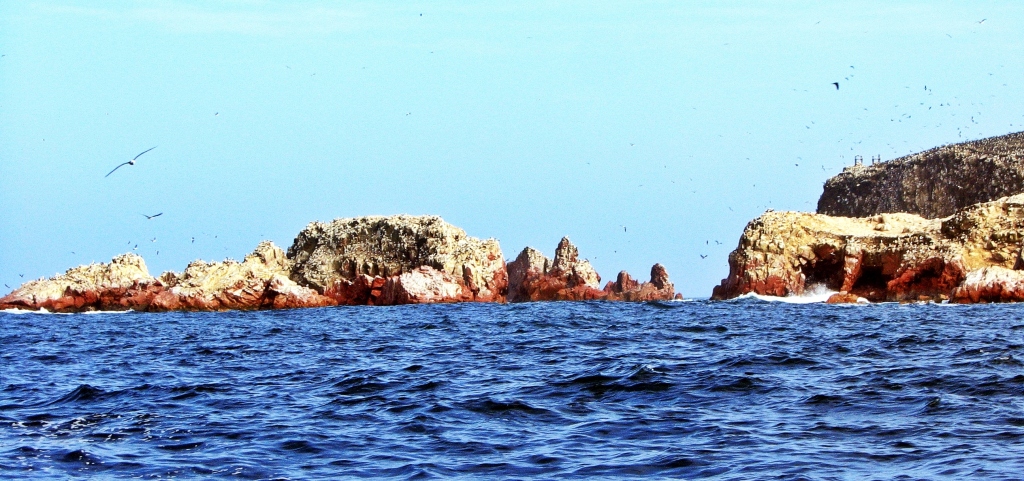
Islas Ballestas 
Sea lion, Islas Ballestas 
Sea lions, Islas Ballestas 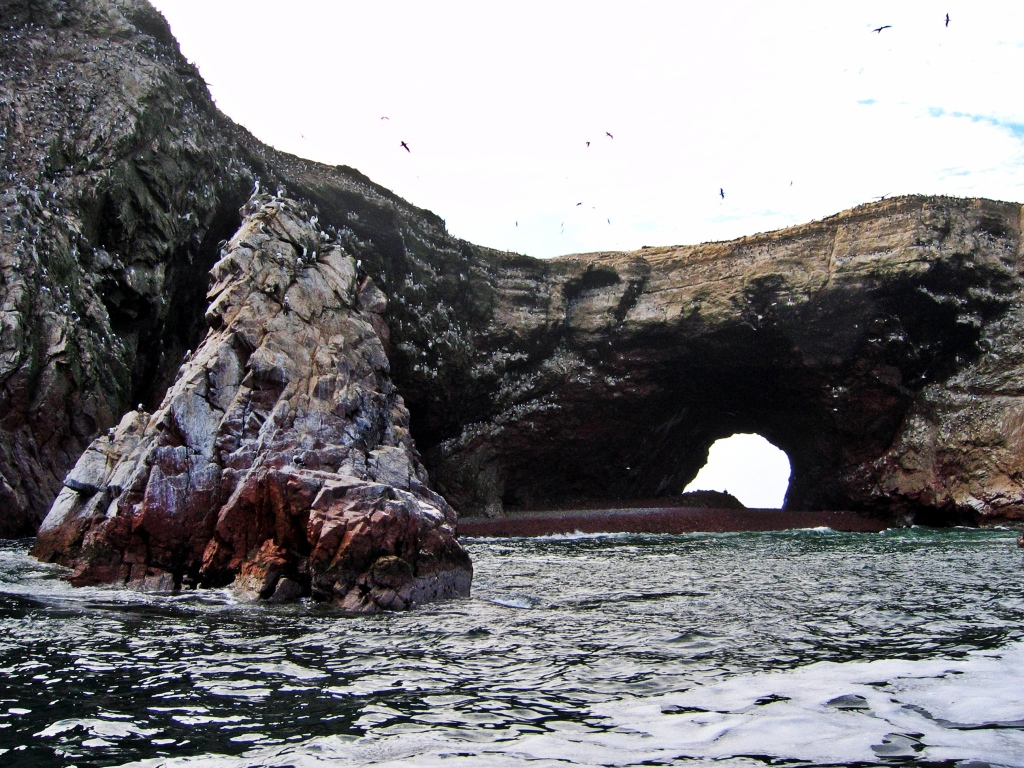
Islas Ballestas 
Islas Ballestas
The reason there is so much wildlife is because of its location. The islands are located near the junction of two currents; the cold Humboldt current and El Nino Southern Oscillation. Depending on the year, these currents result in huge quantities of algae. The algae brings fish, which in turn brings seabirds, sea lions and penguins. Coming from western Canada, we are aware of the effects that La Niña and El Niño have on our weather. El Niño means we will have warmer winter with a lot of snow, great for skiers, but in this part of Peru it means the opposite, cold and dry.
The islands look like they are composed of white rock, but in reality, the white is from bird droppings. The only people allowed on the islands have an unusual job. They collect the guano (bird poop). It’s a major source of fertilizer in Peru.

Cormorants standing on guano, Islas Ballestas 
Guano on Islas Ballestas
On the boat ride to and from Islas Ballestas we passed the 150 m (490 ft) high Candelabra. It’s a geoglyph carved into the side of the cliff in the shape of a candelabra. The cliffs look sandy, but are actually composed of very hard soil. This area gets little wind or rain so the Candelabra has not eroded much. There are opposing theories on its history. Many believe it was created in 200 BC at the time of Nazca Lines, others believe it is more recent and was a signpost for sailors.
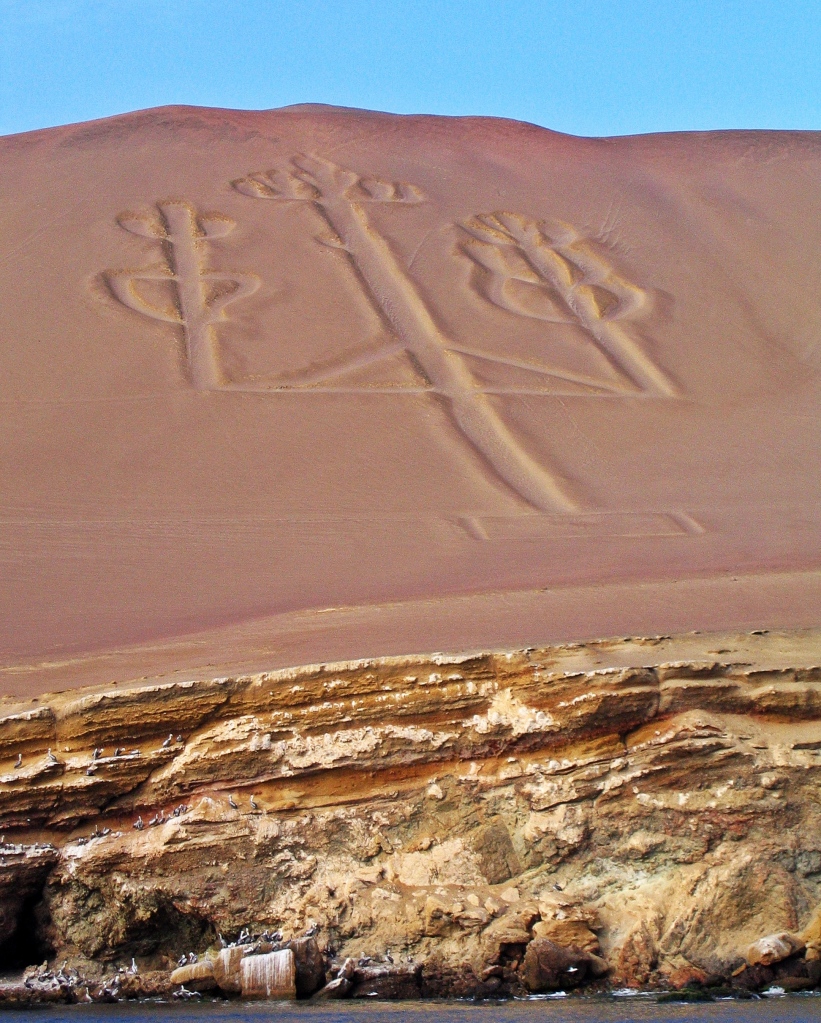
Candelabra, Islas Ballestas
Near the islands is Paracas National Reserve. It is one of the most arid stretches of coast in the world. The Atacama Desert comes right up to the Pacific Ocean, stopping at the gorgeous Red Beach (Playa Roja). An interesting feature is the natural rock formation of La Catedral. When we were there a stone bridge connected the rock to the mainland. Since we visited, an earthquake collapsed the bridge, making the rock an island.

Paracas National Reserve 
Playa Roja, Paracas National Reserve

La Catedral, Paracas National Reserve 
La Catedral after earthquake. Sourced from internet
Nazca Lines
Spread across the arid plain south of Isla Ballestas are the incredible geoglyphs called Naza Lines. There are a staggering 800 lines, 300 geometric shapes and 70 animals and plants. More designs are still being found today. They were made by the Nazca people thousands of years ago by removing small rust coloured stones from the surface and scraping further into the firm ground exposing lighter coloured earth below. The Nazca people worshiped the gods of the mountains and water. Archaeologists believe the geoglyphs were used in rituals to their gods. Although there has been some erosion, most of them are still in remarkable condition.

Nazca Lines
The best way to view the famous Nazca Lines is by flying over them for a bird’s eye view. The lines are barely noticeable at ground level but are remarkable from above. From the plane we could see the details of these massive etchings. The geoglyphs are huge. The condor image below has a wingspan of 130 m (427 ft). It’s amazing to imagine how the Nazca people could have created these massive designs, with such precision, without ever being able to view from above. Here are a few of the animal geoglyphs we saw.
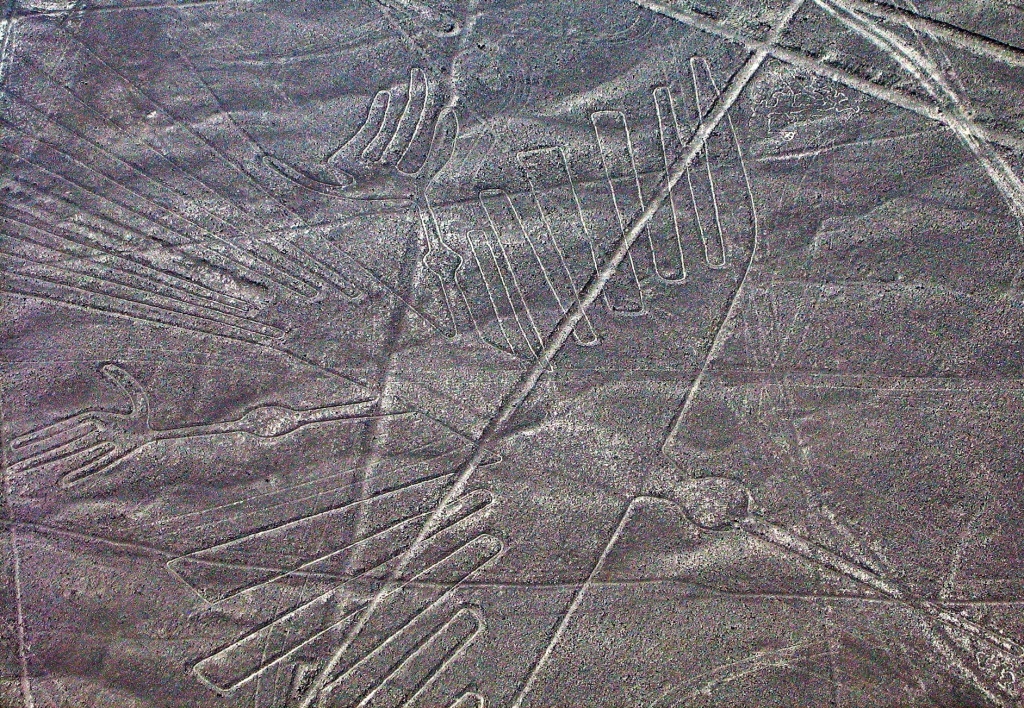
Condor, Nazca Lines 
Astronaut, Nazca Lines 
Dog, Nazca Lines 
Spider, Nazca Lines
To visit Nazca we stayed in Huacachina. It’s a tourist oasis town with bodegas and tall sand dunes for surfing. The town is centered around a picturesque lagoon. Its setting is in stark contrast to the flat dessert of the Nazca Lines.

Huacachina, Peru
Visiting Nazca
Flights usually take off in the morning, after the frequent fog and before the afternoon wind. Planes are small, seating 3 – 9 people. Most tours last 30 minutes and cost around $100 USD. Our pilot flew over each geoglyph from both sides so that people on either side of the plane had a good view. We purchased our tickets at the airport, but this may be a risk depending how busy it is. There are many tour agencies selling tickets in advance.
Chauchilla Cemetery
Not far from Nazca is a fascinating burial ground used by the Nazca people from as far back as 200 AD. Mummified corpses sit in small, mud-brick burials in an isolated desert. The burial rituals included dressing the bodies in embroidered cotton and then painting them with resin. It is the resin and the dry, desert conditions that allowed the mummies to be well preserved after thousands of years.
Today, the mummies are still clothed and are sitting with their heads placed at life-like angles. It feels as if some are looking up at you. Some had headdresses made with feathers from the far away rain forest. Most still have hair and some even still have skin.

Mummies, Chauchilla Cemetery 
Mummy, Chauchilla Cemetery 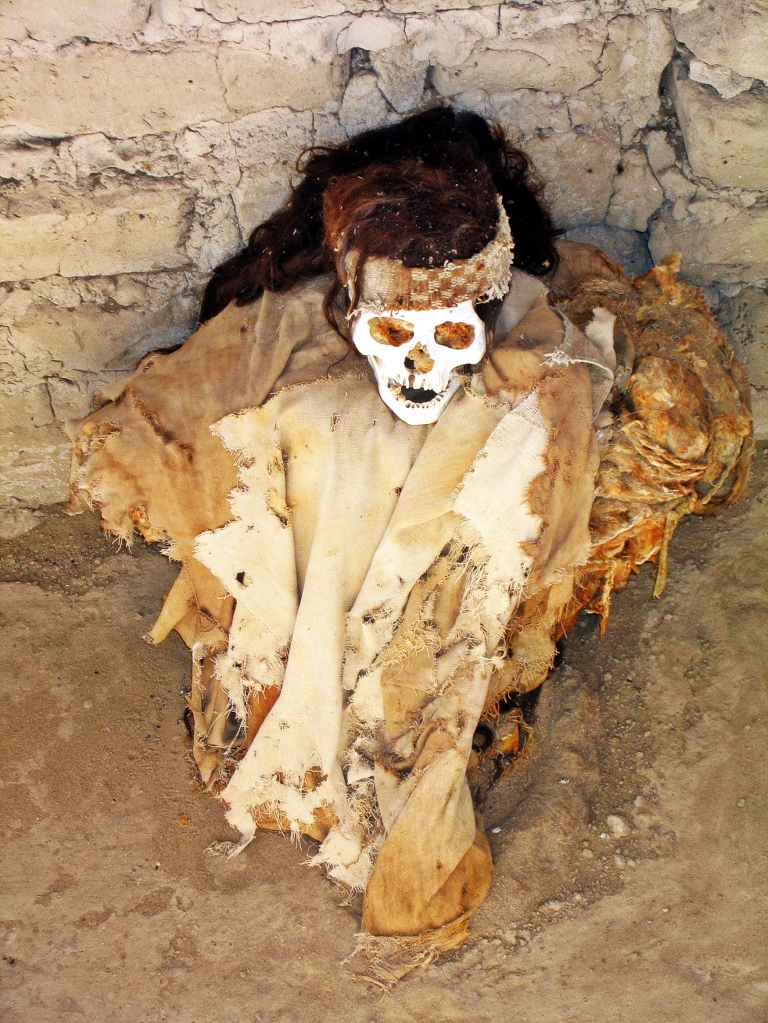
Mummy, Chauchilla Cemetery 
Mummy, Chauchilla Cemetery
The Nazca people were skilled in making pottery and textiles and many mummies were buried with clay bowls filled with food. Apparently, valuables were buried with the mummies as well, but these were taken by grave robbers. Along with the mummies, archaeologists found mummified heads with holes drilled into the skulls. Still not much is known about the purpose of these heads. It’s a creepy, yet fascinating site that shouldn’t be missed when you visit the Nazca Lines.
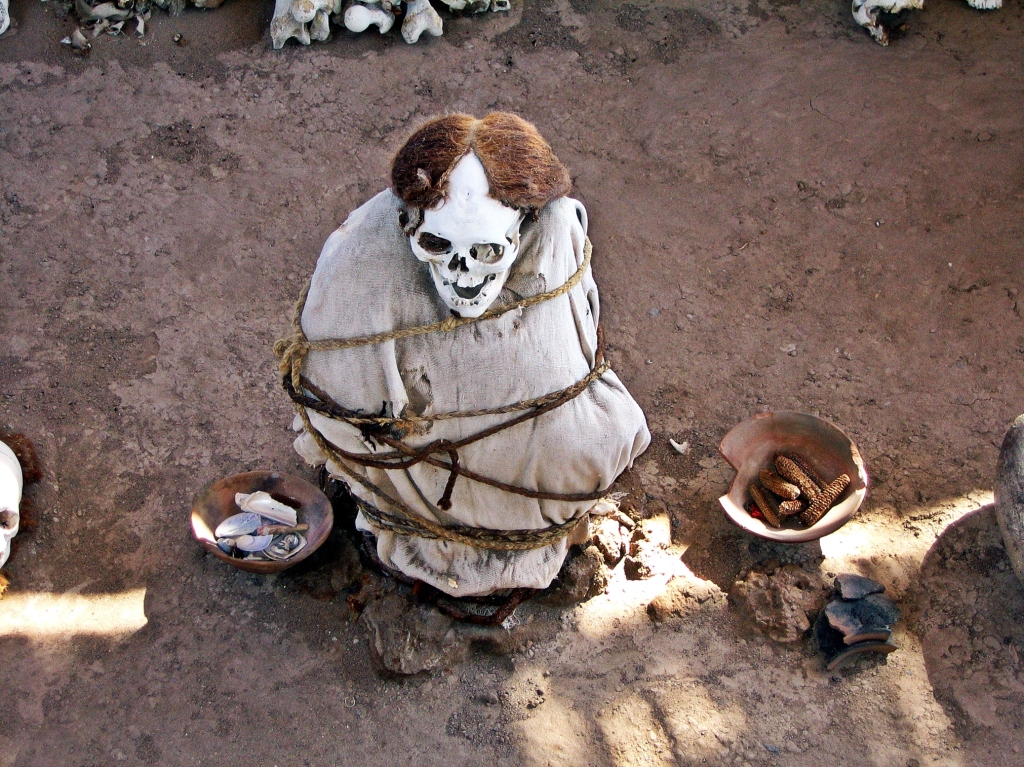
Mummy with pottery and corn, Chauchilla Cemetery 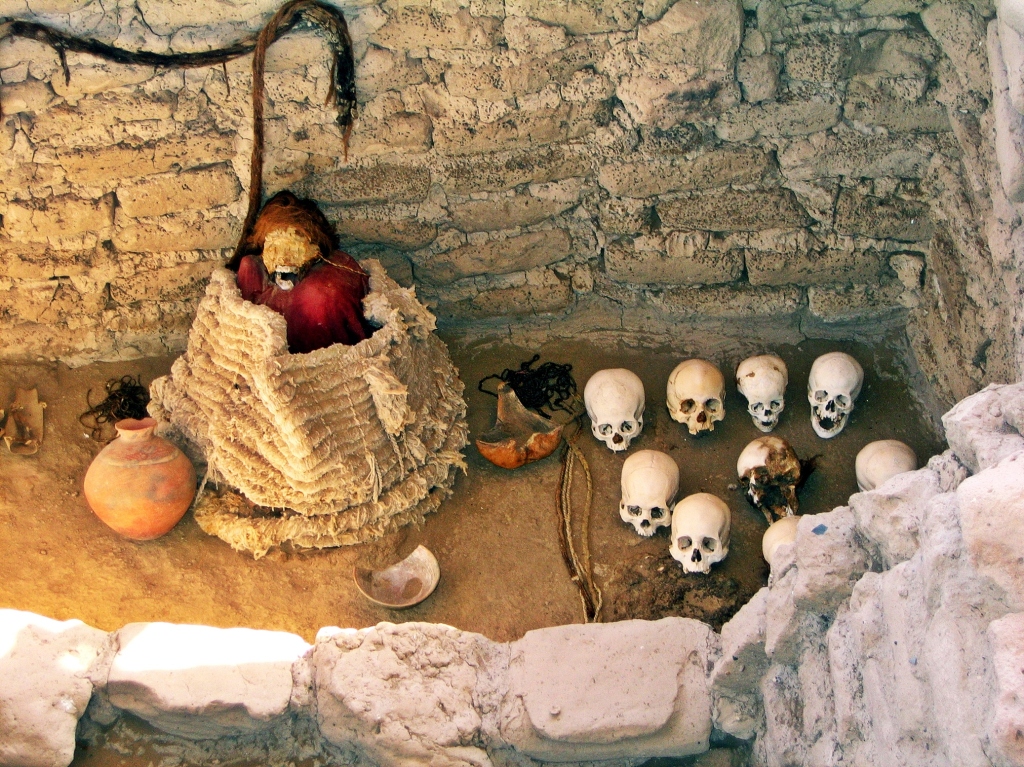
Mummy with skulls, Chauchilla Cemetery
Getting to Chauchilla Cemetery
Chauchilla Cemetery is located 28.5 km (17.7 mi) south-east of the city of Nazca. We hired a taxi for a half day. Make sure the taxi will wait for you as it’s doubtful that there will be any at the site.
Coming Next: A Homestay on Lake Titicaca
For extra pictures from Peru click here. For pictures from other blogs go to Gallery at monkeystale.ca
To read about more of our adventures go to Destinations.
If you like what you read, please comment or share (with credit) using the links below.
Another stunning post!!! An interesting and enjoyable read and, as always, accompanied by some truly wonderful photos. These really are quite captivating. Thanks for taking the time to write this post. Stay Well.
LikeLiked by 1 person
Thank you Colin!
LikeLiked by 1 person
You are very welcome!
LikeLike
A fascinating part of the world, for sure. The Nazca Lines have always fascinated me. Thanks so much for sharing. Hope all is well with you. Allan
LikeLiked by 1 person
Thank you Allan, you would love seeing Nazca Lines.
LikeLike
This looks incredible! Always wanted to visit the Nazca lines, but never knew about the wildlife – and as for the mummies, well….! Thanks for sharing!
LikeLike
Nazca Lines are very impressive, especially to see how huge they are. The mummies were interesting, but a little creepy. Thanks for reading! By the way, I don’t get your posts on my Reader, only by email.
LikeLiked by 1 person
No problem! Thanks for the heads up – we migrated from WordPress.com to .org a couple of months ago, but subscribers don’t seem to have tracked across. Not sure why our old site still appears on the reader without all our newest posts!
LikeLike
Great post 😁
LikeLiked by 1 person
Thank you!
LikeLike
Thanks, now I remember what those islands in south Peru are called. Your pictures certainly brought back a lot of memories! Looking forward to your post on Lake Titicaca, since I remember the floating islands and the men knitting as something really special, although I fear that the lake has become quite polluted according to what I have read.
LikeLiked by 2 people
You many not recognize any of these sites now. It sounds like even Isla Ballestras has gotten a lot busier since we were there. I didn’t notice a lot of pollution on Lake Titicaca, but there was a lot of boat traffic.
LikeLiked by 1 person
I found this article very interesting, it’s a part of Peru that I still have to visit. Thank you for the overview.
LikeLiked by 1 person
Thank you! There’s so much to see in Peru, you’ll have to make another trip!
LikeLiked by 1 person
Ah … some day. I really want to see the Nazca Lines. And Titicaca also so looking forward to reading about that. XXMarie
LikeLiked by 2 people
You really should try to see Nazca Lines when we’re able to travel again. It won’t disappoint.
LikeLike
Fantastic series. The Nazca Lines have long been on my bucket list. How long was your entire south american travels? Am asking to help me plan my own travels. 😊
LikeLiked by 1 person
Nazca Lines are even more impressive in person so you should try to go. Other than getting there for you, Peru is not very expensive. We have been to SA several times, these recent posts are older trips since there’s no traveling. Recently we were in Colombia, Costa Rica, Panama and Belize for 3 months and that was enough time. Peru was 6 weeks and we still didn’t see everything. The other trips were shorter spending only 3 weeks in each country because we were still working. SA is much easier to get to than Asia for us so we’ve been several times, and we love it! If you’re looking at seeing the whole continent, you’ll need 6-8 months at least, but country by country I’d say 4-8 weeks each. That is if you want to try to see a lot. Many people go for 2 or 3 weeks, but you can’t see everything even though the countries are small. Hope that helps a little.
LikeLiked by 1 person
Yes, it does. Thank you so very much! 6-8 months is going to be super difficult since I work. Guess I could aim for exploring the continent country by country. Many thanks once again and also for all your posts. They are fantastic insights and a visual treat.
LikeLiked by 1 person
yes, a 3 week holiday in the whole continent won’t allow you to see much. It would be better to pick a few select locations. Buses and flights make traveling around easy, but there is a lot to see in each country.
LikeLike
The Nazca Lines are soooo interesting. I had no idea there were so many and that they were so large on the ground like that. Really quite something!
LikeLiked by 1 person
They really are amazing, especially to think how long ago they were built. Seeing them from the air was incredible.
LikeLiked by 1 person
these are two things I didnt do when I was in Peru and both really interest me. how did you go about organising this stuff and who with? the Nazca Lines look simply amazing. I would be surprised to learn if they had candelabras in 200BC Peru thought I must admit
LikeLiked by 1 person
Haha, they say that it looks like a cactus as well, but call it a candelabra, for marketing I guess. We really didn’t plan these much. We just showed up at the airport in Nazca and booked a trip that morning. And for Islas, we booked the night before from a tour in town. The areas had tourists, but not as many as you would expect. We were there in July, so high season too.
LikeLike
Islas Ballestas seems to be a paradise. Nazca Lines are on my bucket list. I hope I can make it sometime! very interesting and informative article.
LikeLiked by 1 person
Thanks Nanchi, although small, Islas Ballestas was really fun. It was incredible how many birds were in one concentrated area. Nazca is a must, you really should get there one day.
LikeLiked by 1 person
I hope ya….So many destinations are on the list. Hope to make it soon. Thanks ! 🙂
LikeLiked by 1 person
All fascinating stuff. What a varied post. And the opeining photograph is stunning.
LikeLiked by 1 person
It’s varied and yet, they’re very close together. It’s really interesting geography. Thanks for reading!
LikeLiked by 1 person
We visited many of these sites February 2016 and enjoyed the otherworldly landscape. Imaging living there and knowing nothing else.
LikeLiked by 1 person
That’s true, if that was your whole world, and to be so dependent on the rare rainfall. Life was tough. It does have spectacular landscapes though doesn’t it.
LikeLiked by 1 person
Ahh, the pelicans and the sea lions are certainly a view! I would have loved to do this kind of boat ride. Next time🙂
LikeLiked by 1 person
It was a great tour. So many birds and sealions on such a condensed area.
LikeLiked by 1 person
Wonderful figures of the Nasca figures. I could travel that far just for this.
LikeLiked by 1 person
Nazca is as impressive as you imagine. From the plane you can see how large these images are, and how many. We did a 30 minute plane trip, but you can book private, longer flights to see more.
LikeLiked by 1 person
Galapagos…amazing place to visit…but
..I got so sea sick.
LikeLike
Wow!! What a cool place! An area I know little about but it looks amazing!
LikeLiked by 1 person
We had never heard of Islas Ballestas, but are glad we stopped. We didn’t expect much from Nazca since we thought it was probably over rated, but it was so much better than expected.
LikeLiked by 1 person
That’s always good when it exceeds expectations!!
LikeLiked by 1 person
Every time I read one of your posts I end up adding more places to my list. Out of all these incredible spots, I am most drawn to Paracas National Reserve—there is just something about desert meets ocean. That red colouring is extraordinary.
It is amazing that the Nazca lines were created thousand of years ago, and like you say, without the benefit of seeing them from above.
Great post!
LikeLiked by 2 people
Having the exact same ‘to visit’ list problem here!
LikeLiked by 2 people
These pictures are stunning! Did you have to use a drone for some of them? The ones that are from above? Gorgeous! I love ‘poor man’s Galapagos.’ lol
LikeLiked by 1 person
Thank you, we took a 30 minutes plane ride over the Nazca lines. It was a touristy thing to do, but worth it. Thanks for reading!
LikeLiked by 1 person
Sometimes touristy things are great!
LikeLiked by 1 person
Wow…
What a wonderful place!
LikeLiked by 1 person
Thanks Luisa, Peru has so many interesting places and a lot of variety. Thanks for reading!
LikeLiked by 1 person
🙏🏻💙 🌹
LikeLiked by 1 person